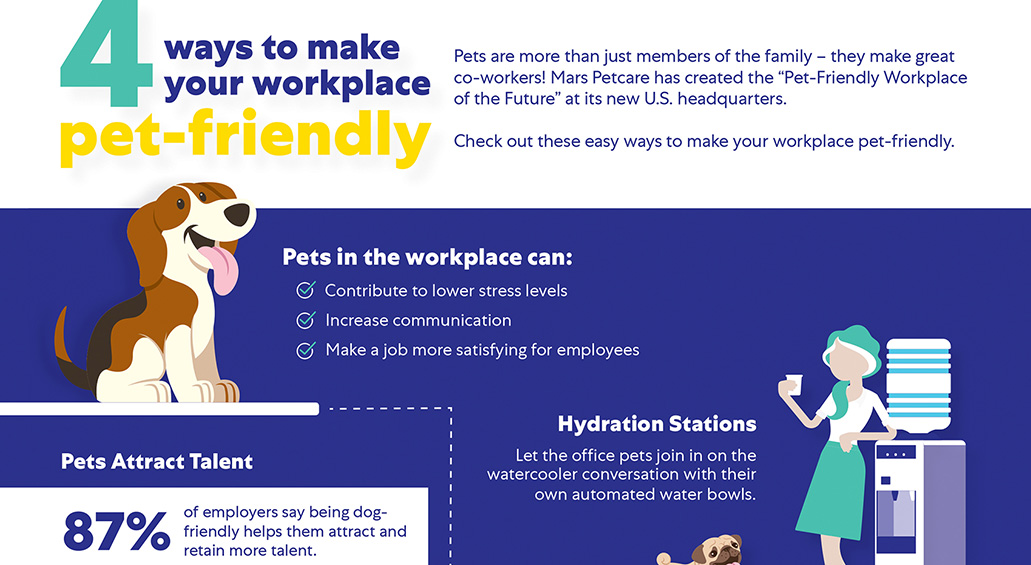Here are answers to some initial questions you might have about pet-friendly workplaces.
Why have pets at work?
Studies show that pets help relieve stress, increase community and boost morale. In fact, a recent survey from the CESAR® brand found that 89% of pet parents said it’s important for them to continue spending time with pets during the workday. Plus, people who have their pets at work feel less pressured to leave at a particular time to get home to their pets. They also take more walking breaks during the day, which supports good health and potentially reduces health care costs. Being pet friendly is also a great recruiting and PR message.
What types of pets should we allow?
This answer depends on your facilities and the interests of your employees. Since dogs are more likely to be leash trained, they are usually the easiest pet type to start with. However, pet parents will know if their cats would do well at work. If you have space, you can also set up a cat play room to give cat visitors a place to play safely together.
What legal considerations are there?
Before starting a pet-friendly workplace program, you’ll want to be sure you meet local rules and regulations for health and hygiene. Also, check that you have the insurance coverage needed to address any incidents that could arise. Be sure to have your legal counsel review your pet policy. Find more considerations here.
What space requirements are there?
At minimum, pet-friendly workplaces should have at least one nearby pet relief area. It should include a pet waste station and trash receptacle that is emptied on a regular basis to control odors. Also, keep in mind that if you do not own your space, you’ll need to get permission from your landlord to be pet friendly and ensure your lease includes that permission. Get more insights here.
How do we ensure good pet behavior?
Many pet parents love the idea of pet-friendly workplaces. They’ll be excited by the chance to bring pets to work, so they’re likely to work hard to help pets succeed. Still, for the protection of everyone involved, you’ll want to have a formal policy that specifies requirements for pet parents, pets and their behavior.
What should be required of pet parents?
Participants must agree to be responsible for their pet’s behavior, well-being, hygiene and happiness. They need to accept all liability for anything that their pet might do or that might happen to their pet while on your premises. Beyond that, they should agree to standards such as keeping their pet controlled, cleaning up any accidents, ensuring that their pet doesn’t disrupt work, and providing pet wellness items like waste bags and water bowls.
What should be required of pets?
You’ll want to ensure that any visiting pets are up to date on vaccinations and free of any communicable infections or parasites such as fleas. They should be house-trained and well socialized, with no history of biting, excessive barking, chasing or aggressive behavior. They also should be covered under their owner’s homeowners or renters insurance policy, which must cover dog bites.
What is required of non-pet owners?
Everyone is affected in pet-friendly workplaces. Non-pet owners will need to be comfortable with the presence of pets and able to get their work done without distraction. As part of creating your pets-at-work program, you will want to determine an escalation process for complaints that might need to be made. Also, think about any accommodations you may want to offer to non-pet owners who prefer not to be near pets.
How do we manage pet accidents?
Accidents happen! So be prepared that they are part of being a pet-friendly workplace. However, accidents are also easily cleaned up. Just be sure to have pet-friendly cleaning supplies available where pet parents can use them. And, as part of your policy, determine if there are any additional steps you would want taken when accidents occur (e.g., pet owners alerting Facilities after an accident so the area can be sanitized).
What types of areas should be pet-free?
This will depend on what your organization does and what equipment you have on site. But generally, pet-free areas are usually places like manufacturing floors, R&D labs, food preparation areas, and areas with equipment that could be broken or be harmful to pets. You also may want to set aside a few spaces for those who have allergies – for example keeping one conference room pet-free so that those with allergies have a protected space when needed for meetings.
Want more tips? Check out the PETS WORK AT WORK™ Toolkit for info about how to start and maintain a successful pet-friendly workplace program.





 Your Privacy Choices
Your Privacy Choices